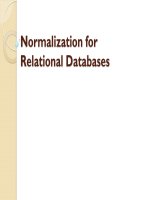Lecture Accounting information systems: Chapter 7 - Richardson, Chang, Smith
Bạn đang xem bản rút gọn của tài liệu. Xem và tải ngay bản đầy đủ của tài liệu tại đây (1.08 MB, 15 trang )
Chapter 7
Conversion
Business
Process
Copyright © 2014 McGrawHill Education. All rights reserved. No reproduction or distribution without the prior written consent of McGrawHill Education.
Learning Objectives
•
•
•
•
•
•
LO#1 Describe the business activities that
comprise the conversion process
LO#2 Develop an activity model of the conversion
process using BPMN
LO#3 Understand and apply different activity
modeling options
LO#4 Develop business rules to implement controls
for the conversion process
LO#5 Develop a structure model for the conversion
process using UML class diagrams
LO#6 Implement a relational database from
the
7-2
LO# 1
Review of Conversion Accounting
7-3
LO# 2
Basic Purchases BPMN Activity Model
The basic activity model implements the process steps.
7-4
LO# 3
Conv er sion Par t ner s
Su n set
I n v ent or y Manager
Refining the Model with Swimlanes
The inventory manager tracks
inventory levels and authorizes new
production
The conversion partners set up
batches and perform work to create
finished signs and banners
First, define one pool and swimlanes showing functional
responsibility.
7-5
LO# 3
Refining the Model with Swimlanes
Then, define the steps performed by each function.
7-6
LO# 3
Refining the Model
Setup
Batch
Batch
Done?
I ssue R/ M
Perform Work
Yes
I nspect Work
No
Discard
Errors
•
Process flow loops until the batch is complete
•
Intermediate error event interrupts flow if
7-7
inspection failed
LO# 3
Refining the Model
Setup
Batch
Batch
Done?
I ssue R/ M
Perform Work
Yes
Inspect Work
All
Done?
No
Yes
No
Discard
Errors
Second loop in process flow until all batches are complete
7-8
Com plete
Production
LO# 4
Business Rules Examples for Conversion
Process
Process
Intention
Partner
Access Controls
Application
Steps
Authority/Action
Controls
Authorize
Production
Partner with proper
authority authorizes
production to
ensure finished
goods available to
meet expected
demand
Supervisor must
authorize
production >
$5,000.
Partner
authorizing
production cannot
modify inventory
records
System must
provide
authorization order
number control,
default values,
range and limit
checks, and create
audit trail
Issue Raw
Material
Issues from raw
material according
to bill of material
recorded accurately
Partner issuing
material must not
be same partner
that authorized
production
Partner recording
issue of material
cannot modify bill
of material
System must only
allow partner to
enter the number of
items issued based
on bill of material,
subject to range
and limit checks on
quantities
7-9
LO# 4
Business Rule Types
Supervisor must authorize
production > $5,000.
Example of Obligatory rule
– states would should
occur
Partner issuing material
must not be same partner
that authorized production
Example of Prohibited rule
– states what should not
occur
7-10
LO# 5
Sunset’s Basic Conversion UML Class
Models
1.
2.
3.
4.
5.
Authorization
Which finished
goods to produce
Records R/M Issue
Specifies the bill of
materials
Records use of labor
7-11
LO# 5
Revised Conversion UML Class
Diagram
Materials
0..*
1..*
Material
Issue
1..1
0..*
Bill of materials promoted
to Type Image
0..*
1..*
1..1
Bill of
Material
1..1
Production 0..*
0..* Authorization
1..*
1..1
1..1
1..1
Sunset
Partners
1..*
1..1
0..*
Products
1..1
Labor
Operations
0..*
1..1
Product
Categories
0..*
Partners responsible for
specific Product
Categories
0..*
7-12
LO# 6
Implementing UML Diagram in a
Database
Materials
0..*
1..*
Material
Issue
1..1
0..*
0..*
1..*
1..1
Bill of
Material
1..1
Production 0..*
0..* Authorization
1..*
1..1
1..1
1..1
Sunset
Partners
1..*
1..1
0..*
Products
1..1
Labor
Operations
0..*
0..*
1..1
Product
Categories
0..*
Database will contain 8 tables to implement classes and 2 linking
tables for the relationship between Purchases and7-13
Products.
LO# 6
Posting Foreign Keys Example
Which tables will get foreign keys?
Material
Issue
0..*
0..*
1..1
Production 0..*
Authorization
1..1
1..1
Sunset
Partners
Foreign keys implement links for one-to-many relationships.
7-14
LO# 6
Database Relationships
Blue arrow highlights linking tables to implement
the two many-to-many relationships.
7-15









